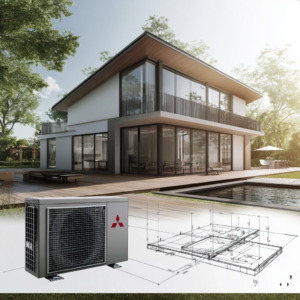Dallas, with its rich history and diverse architecture, boasts beautiful historic homes, particularly in areas like Oak Cliff. These charming residences, often built before the advent of modern air conditioning, present unique challenges when it comes to maintaining comfortable indoor temperatures. Traditional central HVAC systems, with their extensive ductwork, can be difficult, if not impossible, to install in these older structures. This is where mini-split zoning systems offer an innovative and efficient solution.
The Challenge of Comfort in Historic Dallas Homes
Many historic homes in Dallas, especially in neighborhoods like Oak Cliff, were constructed without central air conditioning. While some may have had rudimentary heating systems, such as in-wall or floor heaters, the absence of ductwork makes retrofitting for conventional HVAC a complex undertaking.
- Lack of Ductwork: A primary obstacle is the absence of existing ductwork. Running new ductwork through walls, ceilings, and floors can be invasive, costly, and often compromises the architectural integrity of these historic homes.
- Limited Space: Even in homes that have been partially retrofitted with ductwork, space constraints often hinder effective airflow. Attics, often poorly insulated, were not designed to house bulky HVAC units and extensive duct systems.
- Insulation and Windows: Adding to the challenge is the typically poor insulation in these older homes. Walls, crawl spaces, and attics often lack adequate insulation, and original single-pane windows contribute to significant energy loss and temperature fluctuations. This makes it difficult for traditional HVAC systems to maintain consistent comfort, especially near exterior walls.
- Inefficient Existing Systems: Some homes may have outdated or inefficient HVAC systems that struggle to keep up with Dallas’s extreme temperatures. These systems often result in uneven temperatures throughout the house, with some rooms feeling too hot or too cold.
Mini-Split Zoning: A Modern Solution for Historic Homes
Mini-split systems, also known as ductless mini-splits, offer a versatile and efficient alternative to traditional central HVAC. These systems consist of an outdoor unit (containing the compressor and condenser) and one or more indoor units (air handlers) that are connected by refrigerant lines and electrical wiring.
- No Ductwork Required: One of the most significant advantages of mini-splits is that they don’t require ductwork. This makes them ideal for historic homes where installing ducts is impractical or impossible.
- Zoned Comfort: Mini-splits allow for zoned heating and cooling, meaning you can control the temperature in individual rooms or zones independently. This is particularly beneficial in historic homes where different areas may have varying heating and cooling needs. For example, a sunroom may require more cooling than a shaded bedroom.
- Energy Efficiency: Mini-split systems are highly energy-efficient, often exceeding the efficiency of traditional HVAC systems. This can translate to significant energy savings for homeowners.
- Quiet Operation: Unlike noisy window units or traditional HVAC systems, mini-splits operate quietly, providing a more comfortable and peaceful indoor environment.
Multi-Zone Systems: The Ultimate in Comfort and Control
For larger historic homes or those with multiple rooms requiring individual temperature control, multi-zone mini-split systems are an excellent choice. Systems like the Mitsubishi MXZ models allow you to connect multiple indoor units to a single outdoor unit, providing customized comfort throughout the entire home.
- Versatility: Multi-zone systems offer a wide range of indoor unit styles, including wall-mounted units, ceiling cassettes, and concealed duct units. This versatility allows for seamless integration into various room designs and architectural styles.
- Customization: With multi-zone systems, you can create customized temperature zones to suit the specific needs of each room or area. This ensures optimal comfort for everyone in the household.
- Combining Options: Mini-split systems are incredibly versatile. They offer the option to combine both ducted and ductless air handlers within the same system. This means you can use ductless units in areas where ductwork is impossible and utilize small, discreet ducted units in areas where they are feasible.
Real-World Results in Dallas’s Historic Neighborhoods
Truficient Energy Solutions has extensive experience installing mini-split systems in historic homes throughout the Dallas-Fort Worth area, including Oak Cliff and Richardson. We’ve seen firsthand the positive impact these systems have on homeowners.
- Improved Comfort: Homeowners consistently report significant improvements in comfort after installing mini-split systems. They appreciate the ability to control the temperature in individual rooms and eliminate hot and cold spots.
- Quiet Operation: One of the first things homeowners notice is how quiet the systems are compared to their previous HVAC setups.
- Increased Energy Efficiency: Many homeowners experience lower energy bills after switching to mini-split systems, thanks to their high energy efficiency.
Choosing the Right System and Installation
Selecting the right mini-split system and ensuring proper installation are crucial for optimal performance and longevity. It’s essential to work with a qualified HVAC contractor with experience in installing mini-split systems in historic homes.
- Professional Assessment: A qualified technician will assess your home’s specific needs, taking into account factors such as size, layout, insulation, and window efficiency.
- System Design: Based on the assessment, the technician will design a customized system that meets your specific requirements.
- Expert Installation: Proper installation is essential for optimal performance and efficiency. A qualified technician will ensure that the system is installed correctly and that all connections are secure.
Key Benefits of Mini-Split Systems for Historic Homes:
- No ductwork required, preserving architectural integrity.
- Zoned heating and cooling for customized comfort.
- High energy efficiency for lower utility bills.
- Quiet operation for a peaceful indoor environment.
- Versatile installation options to suit various home styles.
Conclusion
For homeowners in Dallas’s historic neighborhoods, mini-split zoning systems offer a modern and efficient solution for achieving optimal comfort without compromising the character of their homes. If you’re struggling with inconsistent temperatures, high energy bills, or the challenges of retrofitting traditional HVAC in your historic home, consider exploring the benefits of mini-split technology. Contact a qualified HVAC professional like Truficient Energy Solutions to learn more about how these innovative systems can transform your living space.
Need Help Choosing the Right Multi-zone System for Your Older Home?
Need Help Choosing the Right Multi-zone System for Your Older Home? Navigating the complexities of HVAC in older homes requires specialized knowledge. Truficient Energy Solutions has extensive experience working with these types of properties. Contact us today for expert guidance and a tailored solution.








